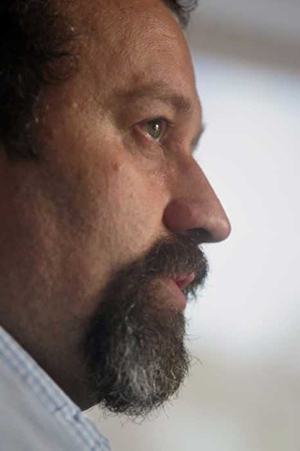
Andrew Curtis
Each week, we will profile a scholar who will present his or her research at the Center for Advanced Genocide Research's upcoming conference Digital Approaches to Genocide Studies, Oct. 23-24, 2017.
How well can you map your route home from work by memory? Give it all the detail you can – the tiny yellow flowers you always pluck up absently while you’re waiting for the bus to roll up; the way it smells when you cross the river; the bump in the road that happens before the sharpest turn on your commute and the rumbling you always hear from the broken hydrant three streets away from your stop.
Now try it again, but know that someone else is there to pick up wherever you’ve forgotten a feature – or more, a whole series of someones else. And then, based on your testimony and those of all of those other someones, another someone will map your commute.
This is a loose way of explaining how Andrew Curtis, professor in the Department of Geography at Kent State University, has used testimony to build and map out the narratives of survivors of the Cambodian genocide. He’ll be presenting his methods in October at USC Shoah Foundation’s 2017 International Conference “Digital Approaches to Genocide Studies,” co-sponsored by the USC Mellon Digital Humanities Program.
The two-day conference, which will be held at the University of Southern California in Los Angeles, invites select scholars from across the globe to converge and discuss the relationship between digital methodologies, practices, ethics and the nature of contemporary Holocaust and Genocide Studies.
“I will be presenting a new method at the conference – a spatial video geo-narrative,” Curtis said. “Briefly, this means a commentary is collected along with spatially enriched video. Using software [my team] has developed, these narratives, once transcribed, can be mapped and analyzed using spatial and non-spatial approaches.”
At the conference, Curtis will demonstrate his method of mapping using the initial evacuation of Phnom Penh during the Cambodian genocide – but he says the method can be applied in other genocide investigations as well.
“This is the first time that these routes have been mapped, but more importantly, the routes will be contextualized by what happened at specific locations on these forced marches,” Curtis said.
Curtis’s presentation will be one of several to use geographic information system systems for analyzing genocide and Holocaust spaces, one answer of many to the conference’s prompt: How can digital humanists from a range of disciplines and methodologies broaden our methodological approaches to study the causes, consequences and prevention of genocide?
“I truly believe this technique has the potential to be an invaluable ‘tool’ for genocide researchers – especially where living memories and institutional knowledge can be accessed through fieldwork,” Curtis said. “The methods we will present will allow a researcher to record an interview with spatial content, and be able to link those comments to the actual coordinates and visuals. This not only provides a way to record and map these types of data, but the sights, sounds and smells of places and environments also generates recalls that would not happen in a more ‘sanitized’ interview.”
As the Director of the GIS Health and Hazards Lab at Kent State University and former Director of the World Health Organization’s Collaborating Center for Remote Sensing and GIS for Public Health, Curtis has a wealth of knowledge to share with fellow conference attendees. His extensive bibliography includes studies of the spatial nuance of a region’s drug hotspot; conflict and polio in Afghanistan; case studies in post-disaster recovery, crime, mosquito control and tuberculosis in the homeless; and much more.
“I have always worked in the area of mapping challenging places, locations that are data poor but at the same time have important societal problems,” Curtis said. “The homeless, informal settlements, post-disaster locations and epidemics have all provided case study sites.”
His work with Professor James Tyner at Kent State led him to the project he’ll be presenting, which he hopes will excite fellow conferences attendees and spark desires to explore collaboration. While he and his team have over 15 different overseas collaborations, he’d like to continue to expand the use of this new method, in spirit with the goals of the USC Shoah Foundation Center for Advanced Genocide Research, which is dedicated to advancing new areas of interdisciplinary research on the Holocaust and other genocides, focusing on the origins of genocide and how to intervene in the cycle that leads to mass violence.
Though Curtis worked at the University of Southern California for five years, he did not use the Institute’s Visual History Archive – a collection of 54,000 digitized and fully searchable video testimonies from survivors and other eyewitness of the Holocaust, the Rwandan, Guatemalan and Armenian genocides and the Nanjing Massacre in China – in his research until he began working with Tyner.
It was then that he learned of the value of the Archive to his research.
“The methods I have created exist because of my belief that testimony and individual context and institutional knowledge is vital to our understanding of why, where and how events occur,” Curtis said, “whether that is an emerging epidemic, drug overdoses, fear of violence or recording the happenings around an important historical or political situation. By capturing these perspectives, we enrich understanding through detail, which is vital to develop and refine theory…Centers such as USC Shoah Foundation provide an invaluable piece to my process – a focal point to encourage discussion and collaboration – and a physical resource where interviews can be stored safely for all time.”
The symposium will begin October 23 in Los Angeles. For more information, look here.